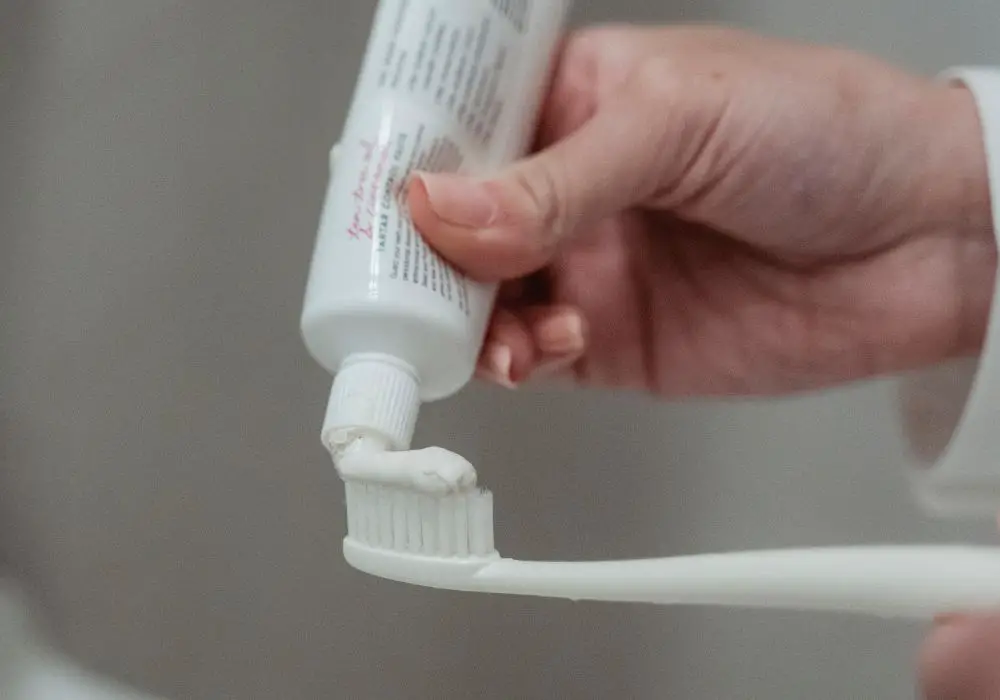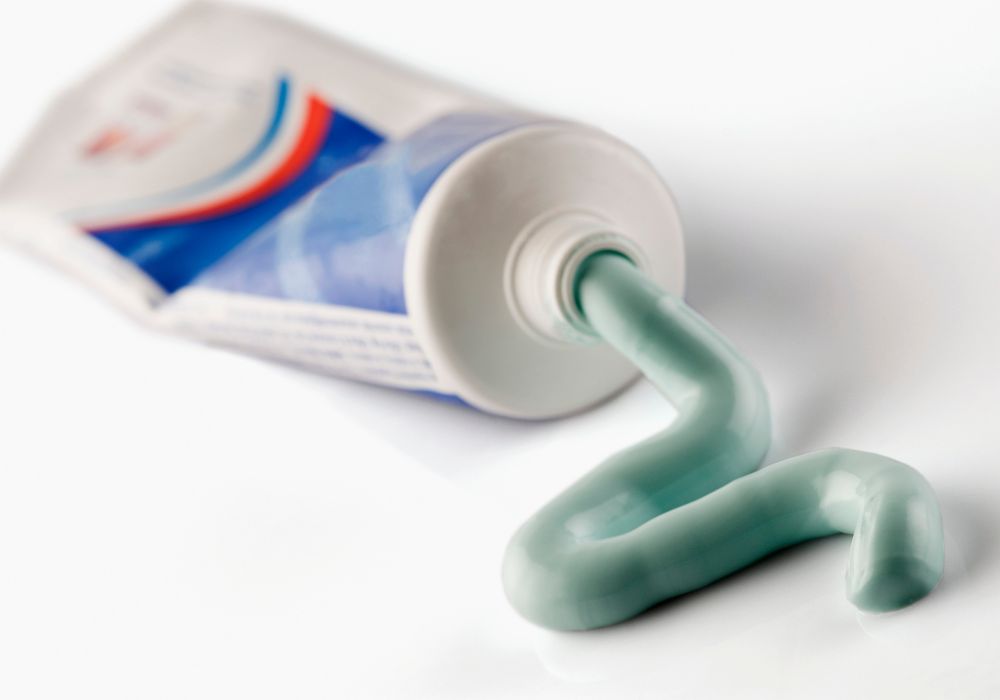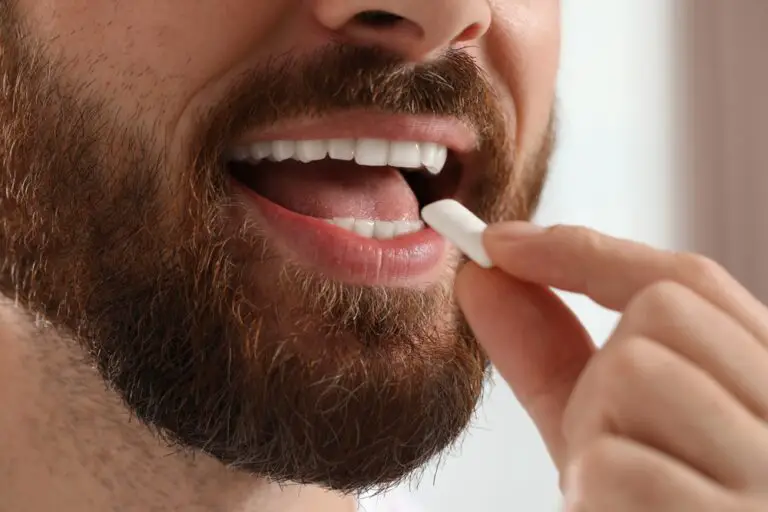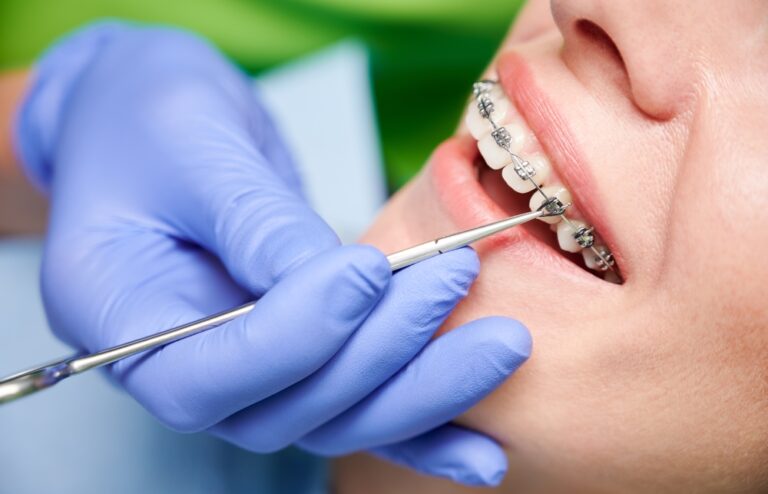Calcium carbonate is an ingredient found in the majority of conventional toothpastes, yet few consumers realize why it is added. This common abrasive plays a crucial role in optimizing toothpaste’s cleaning and polishing performance. By understanding calcium carbonate’s properties and alternatives, you can make an informed choice about the best toothpaste for your needs.
An In-Depth Look at the Purpose of Toothpaste

Before examining calcium carbonate specifically, it’s important to cover the core goals of toothpaste in depth:
Removing Dental Plaque and Food Debris
Toothpaste aims first and foremost to clean teeth by removing the buildup of dental plaque and food particles. Dental plaque is a sticky film of bacteria, food debris, saliva, and gingival crevicular fluid that accumulates on teeth. Plaque contributes to cavities and periodontal disease if not adequately removed by brushing and flossing. Food can become trapped in tiny grooves on tooth surfaces, contributing to plaque formation. Toothpaste provides mild abrasive action to dislodge and scrub away these deposits.
Polishing Away Stains on Enamel
In addition to cleaning, toothpaste seeks to polish teeth by removing stains on the enamel surface. Certain foods and drinks like coffee, tea, and red wine can discolor the enamel over time. Nicotine from tobacco use also causes stubborn surface stains. The abrasives in toothpaste buff away these stains to reveal whiter, shinier teeth. This polishing action depends on the right amount of grit to get the job done without damaging enamel.
Delivering Active Ingredients Like Fluoride
One of the most important jobs of toothpaste is delivering active ingredients to teeth and gums. The star ingredient is fluoride, proven to strengthen enamel and prevent cavities. Fluoride in toothpaste integrates into the tooth crystalline structure, making enamel more resistant to acid attacks from plaque bacteria that erode enamel. Fluoride also inhibits bacterial metabolism and growth, reducing plaque production. Xylitol and antimicrobials like triclosan may also be added to fight bacteria and gingivitis.
Freshening Breath by Masking Odors
Toothpaste contains flavorings like peppermint not only for taste, but to give your mouth a clean, fresh sensation. Essential oils provide fragrance that masks odors caused by stale food particles, tobacco, garlic, onions, and smelly bacteria in the mouth. Menthol additives also provide a cooling, tingly mouthfeel.
Providing Flavorings and Sweeteners for Taste Appeal
Flavorings like sweet fruits and mint go beyond just fresh breath – they make toothpaste enjoyable to use. Sweeteners like saccharin improve palatability. Flavor and sweetness make daily oral hygiene more pleasant.
To accomplish all these goals, toothpaste contains several functional ingredients. Let’s examine the roles of these components:
Key Toothpaste Ingredients and Their Purposes
Abrasives
As discussed, abrasives provide the scrubbing and polishing action that removes plaque and surface stains. Calcium carbonate, silica, and baking soda are examples of mild abrasives added to toothpaste.
Humectants
These ingredients like glycerin and sorbitol help retain and prolong moisture content. They prevent the paste from drying out in the tube or bathroom sink.
Binders
Thickeners like sodium alginate give toothpaste a gel-like viscosity that clings to a toothbrush rather than dripping straight through the bristles. They bind the formula together.
Surfactants
Detergents like sodium lauryl sulfate (SLS) are added to create foaming action. Foam helps distribute toothpaste around the mouth and between teeth. It also aids the mechanical cleaning process.
Flavors & Sweeteners
Flavorings like peppermint, spearmint, and saccharin improve taste and freshen breath. Essential oils add fragrance.
Fluoride
Most toothpastes contain fluoride at concentrations around 1,000 to 1,500 ppm. Sodium fluoride and stannous fluoride are common sources.
Antimicrobials
Agents like triclosan, chlorhexidine, and CPC (cetylpyridinium chloride) inhibit the growth of bacteria that contribute to plaque, gingivitis, and bad breath. However, triclosan use is on the decline due to regulation.
Why Use Calcium Carbonate in Toothpaste Formulations?

Now that we’ve covered the basics of toothpaste’s ingredients and purposes, we can examine why calcium carbonate has become a preferred abrasive.
Calcium carbonate is valued for the following key properties:
Mildly Abrasive Cleaning and Polishing Action
The main role of calcium carbonate is to provide gentle yet effective abrasion for scrubbing away plaque and surface stains on enamel. It cleans without being too harsh or damaging to enamel.
Low Water Solubility
With its crystalline structure, calcium carbonate does not readily dissolve in water or saliva. This means it retains its abrasive action throughout the brushing process. In contrast, abrasives like baking soda tend to dissolve rapidly with use.
Compatible with Fluoride
Importantly, calcium carbonate is compatible with fluoride unlike some other abrasives. It will not negatively interact or compromise the efficacy of fluoride in toothpaste formulas. Maintaining fluoride bioavailability is essential.
Low Cost and Wide Availability
As an abundant mineral, calcium carbonate is easy and inexpensive to source in large quantities needed for mass production of toothpaste. This helps keep manufacturing costs down compared to less common abrasives.
Due to these advantages, calcium carbonate is incorporated into many major toothpaste brands at levels around 10-40%.
Origins and Manufacturing of Calcium Carbonate Abrasive
The calcium carbonate used in toothpaste and other industries is sourced from natural limestone, marble, chalk, coral, and oyster shell deposits. It is milled and processed into a fine powder optimized for abrasive applications.
Factors like the particle size, shape, and hardness determine the abrasive properties. For toothpaste, a particle size of 10-50 microns provides optimal cleaning without high enamel wear. The calcium carbonate may be made from a combination of course particles for cleaning and finer particles for polishing in a process called stacking.
Manufacturers can control attributes like the hardness, grittiness, and solubility by varying factors like the mineral source, particle size and shape, and processing methods. This allows customizing the calcium carbonate properties for a given toothpaste’s formulation goals.
While calcium carbonate is popular, there are alternative abrasives used in some toothpastes. Let’s take a detailed look at the pros and cons of each option:
Silica
Silica, more formally known as silicon dioxide, is a mineral like quartz. In toothpaste, it appears as a white powder of very fine particles. With a Mohs hardness around 7, silica is harder than enamel at 5. This allows it to abrade and polish teeth effectively. However, silica may be overly abrasive for daily long-term use for some individuals.
Pros: Highly effective polishing, very smooth texture
Cons: Potentially abrasive on enamel, costs more than calcium carbonate
Aluminum Oxide
Also called alumina, aluminum oxide is added for its highly abrasive properties due to its Mohs hardness of 9. However, this hardness also makes it too abrasive for daily use. It is better suited to occasional use for stain removal like in whitening toothpastes.
Pros: Extremely effective abrasion for stubborn stains
Cons: Too abrasive for daily use, expensive, does not polish well
Calcium Phosphate
Like calcium carbonate, calcium phosphate provides a source of calcium ions. It may also help remineralize enamel due to its phosphate content. However, it tends to have a gritty, chalky texture.
Pros: Provides calcium and phosphate, compatible with fluoride
Cons: Gritty texture
Baking Soda (Sodium Bicarbonate)
Baking soda is a popular natural abrasive and alternative to calcium carbonate. It provides a deep, mechanical cleaning. The drawbacks are the bitter, salty taste many dislike and the tendency to dissolve quickly during brushing compared to calcium carbonate. Baking soda also neutralizes acids in the mouth.
Pros: All-natural, helps neutralize acids
Cons: Unpleasant taste, dissolves fast
When choosing between abrasives, makers must balance factors like cleaning power, taste, grit, cost, and safety. The majority find that calcium carbonate offers the best balance.
Additional Benefits Provided by Calcium Carbonate

Aside from mechanical cleaning, calcium carbonate offers secondary benefits:
Neutralizes Acid and Raises Mouth pH
Like other sources of calcium ions, calcium carbonate helps neutralize acid and raise pH in the mouth. This counters the erosive effect of acids from foods and plaque bacteria. Higher pH promotes enamel remineralization.
Provides a Supplemental Source of Calcium Ions
The calcium in calcium carbonate offers a small boost to your daily calcium intake. Calcium is essential for building and maintaining strong enamel. Though minimal, the extra calcium can help strengthen teeth.
Improves Texture and Mouthfeel
The gritty texture of calcium carbonate gives toothpaste a perceptible cleaning action. It provides friction against teeth for scrubbing while still being fine enough for a smooth paste.
Potential Concerns and Risks Regarding Calcium Carbonate in Toothpaste
Given its long history and widespread use, calcium carbonate has a well-established safety profile. However, some concerns have been raised:
Gritty Texture
While the gritty texture provides tangible cleaning action, some object to its coarse feel in the mouth. Individuals accustomed to smoother silica may perceive calcium carbonate as scratchy. This textural preference varies by consumer.
Possible Enamel Abrasion
There is disagreement on whether calcium carbonate over-abrades and damages enamel over long term use. However, studies show minimal enamel loss with mainstream calcium carbonate toothpastes when used properly twice daily. Moderate use should not pose enamel risks.
Allergic Reactions
A small percentage of users may be allergic to calcium carbonate and experience symptoms like skin rashes, mouth sores, and digestive upset. However, these allergies are uncommon and mild.
For most people, these concerns do not outweigh the benefits of calcium carbonate for cleaning efficacy and safety. However, individuals should discuss preferences and any reactions with their dentist.
Guidelines for Selecting the Best Toothpaste Based on Your Needs
When choosing a toothpaste, consider the following:
- If you want advanced stain removal, seek out toothpastes with more effective but harsher abrasives like aluminum oxide, but limit to occasional use only.
- If you dislike texture, try silica instead of calcium carbonate for a smoother paste.
- If you have sensitivity, use formulas with ingredients like strontium chloride or stannous fluoride to relieve pain.
- If you want the benefits of baking soda, get a natural toothpaste formula that uses it instead of calcium carbonate.
- If you have no special needs or issues with calcium carbonate, then a mainstream toothpaste with it is likely a safe, effective option.
Discuss any questions or concerns about toothpaste selection with your dentist or dental hygienist.
The Bottom Line
Calcium carbonate is proven to be an effective, low-risk abrasive and cleaning agent in toothpaste. It provides ideal grit and polish without excessively abrading enamel. The benefits of calcium carbonate in optimizing cleaning, compatibility with fluoride, neutralizing acid, and contributing calcium outweigh minor drawbacks around texture preference and the unlikely risk of allergy. While some viable alternatives exist in certain toothpastes, for the majority of consumers, calcium carbonate poses no safety issues and helps create an optimal daily toothpaste.
Frequently Asked Questions
Why is calcium carbonate less abrasive than other minerals like sand particles?
Sand particles used for abrasives are quartz, a much harder mineral than calcium carbonate on the Mohs hardness scale. The hardness of quartz makes sand particles more likely to scratch and damage enamel. Calcium carbonate is soft enough provide cleaning action without scraping away enamel over time.
Can calcium carbonate particles become embedded in your teeth?
No, the calcium carbonate particles are too large to penetrate or become lodged in intact tooth enamel. Particles range from 10 to 50 microns in size, much larger than the nano-scale pores in enamel crystal structure. Calcium carbonate particles provide surface cleaning only and do not get stuck in teeth.
Is the texture of calcium carbonate toothpaste too rough and gritty?
Sensitivity to texture is subjective based on personal preference. Some find the palpable grit of calcium carbonate provides a pleasant cleaning sensation. However, others accustomed to finer abrasives like silica may find it too rough. There are smooth-textured alternatives without calcium carbonate for those who dislike the moderate grit.
Does calcium carbonate toothpaste provide a meaningful amount of calcium?
The amount of absorbable calcium from brushing is negligible compared to dietary sources of calcium like dairy products. However, the small extra boost can provide a minor supplement to help strengthen enamel. Every bit contributes.
Are there environmental concerns around mining calcium carbonate?
Commercial calcium carbonate comes from abundant limestone, marble, and shell deposits, limiting environmental harms. However, some sources may be more sustainable than others, so check manufacturer sustainability practices. Overall, calcium carbonate is relatively eco-friendly compared to less common minerals.







